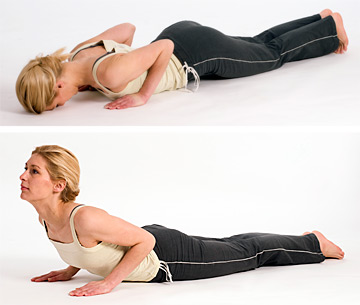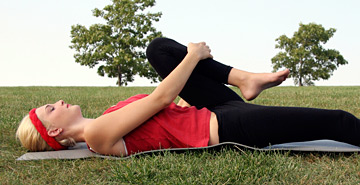Whenever I see a patient with back pain, I always ask, “What do you do when you are in pain? What exercises help your pain?” I am continually surprised that very few patients know what self-care to do when they have an acute episode of pain. That includes motivated patients and patients I have seen before and carefully shown the right exercises. Maybe it is because when you hurt, you stop thinking clearly; or maybe it is fear that the pain will get worse. Both are valid excuses. Most of them just rest, ice the area, and use non-steroidal anti-inflammatory drugs (without realizing that NSAIDs actually block healing). Many of them say, “I hurt too much to exercise.”
Why Movement Matters
 The problem with this is that when you stop moving, when you are still, everything tightens up, circulation slows down, and pain chemicals accumulate in your muscles and joints. It’s like waking up after sleeping in a cold room on a lousy mattress with a draft. If you get moving, you’ll typically start to feel better.
The problem with this is that when you stop moving, when you are still, everything tightens up, circulation slows down, and pain chemicals accumulate in your muscles and joints. It’s like waking up after sleeping in a cold room on a lousy mattress with a draft. If you get moving, you’ll typically start to feel better.
So, here’s the number-one rule to remember: Don’t stop moving when you hurt. I know, you are in pain and afraid to move, and sudden movements may cause your back to “grab” or spasm. I am not telling you to ignore the pain. What I am saying is that you need to find movements that will ease your pain. In many cases, the most important thing to do when you hurt is to keep moving. The body often tightens up and limits your motion. If you find a motion that doesn’t hurt you, it will probably help you. When you are hurting, you may not be able to do your usual activities, but you must keep moving. Try walking slowly, especially on flat and even ground. Try walking up a hill (you can walk up a hill without walking down, on a treadmill). Try swimming or simple motions in chest-deep water. Try basic pelvic tilts, staying within a pain-free range.
Here are some basic principles. The movement should be pain free (or at least cause minimal pain while being performed). When you have finished doing the exercise, your pain should be somewhat diminished. You should feel that you can move more freely. Your back should feel straighter and less “kinked.”
 Backward bending is a great exercise when you’re suffering from low back pain. Start on the floor or other stable surface (top picture), then slowly raise your upper body up while keeping your lower body stationary (bottom picture). The final step involves extending your arms up (much like a push-up).Basic Exercises for Low Back Pain
Backward bending is a great exercise when you’re suffering from low back pain. Start on the floor or other stable surface (top picture), then slowly raise your upper body up while keeping your lower body stationary (bottom picture). The final step involves extending your arms up (much like a push-up).Basic Exercises for Low Back Pain
Here are two basic examples of self-care exercises that have stood the test of time. Many of my patients have found variations on these and other types of movements that act as “reset” buttons for their typical pain. You are the one living in your body; you are the most likely one to know what is working for you.
Lower back diagnosis is often very difficult and confusing. For the sake of this article, let’s divide low back pain exercises into two categories: exercises that make your back feel better when you bend backward, and exercises that make your back feel better when you bring your leg toward your chest.
Backward Bending (extension of the lumbar spine). An exercise called the McKenzie extension is the first thing you should try if you have sciatica (pain running down your leg). If these exercises work, your pain will diminish and may centralize, which is a good thing. Centralize means your pain goes less far down your leg, and you may feel it closer to the spine. Bending backward may not feel good at first, but you should feel better immediately afterward. If you feel worse afterward or the pain goes farther down your leg, stop, as this is not the exercise for you.
How to Do It: Lie face-down on the floor, arms bent at your sides (sort of like a starting push-up posture). Straighten your arms up slowly, lifting your upper body off the floor as you do so. Your legs and feet should stay on the ground. Hold for 3-5 seconds, then slowly lower your upper body back down. Repeat 10 times, as often as once per hour.
If your pain or restriction is on one side, a variation on McKenzie extension (lying on a raised surface with one leg on the floor, slightly bent) may be more comfortable (keep the elevated leg straight).
Flexion Exercises (bringing the leg toward the chest). People with lower back pain can also feel better with various types of leg flexion, bringing the bent leg toward the chest, or doing contract-relax and then bringing the bent leg toward the chest. These people usually have sacroiliac joint problems. (The SI joints are located on either side of the spine in the lower back.) These are also called Tigny exercises.
How to Do It: Lie on your back with one leg bent and then other flat on the floor. Bring the bent leg up toward the chest. Wrap your arms around the leg and then try to lower it toward the floor for 3-5 seconds, resisting with your arms. Relax, and then pull the bent leg up farther toward the chest. Repeat the entire process three times.
 Flexion exercises are another great way to relieve lower back pain. Lie on your back with one leg bent and the other leg flat on the floor. Raise the bent leg toward the chest, wrap your arms around the bent leg, and then try to lower it toward the floor as you resist with your arms.Repeat with the opposite leg.I have included a series of links at the end of this article; the first two go to videos describing the basics of McKenzie extension. The third one goes to an article I wrote describing the basic McKenzie extension exercise, and a couple of other variations. The fourth link goes to Dr. Craig Liebenson’s site, LA Sports and Spine, where you can download his article and pictures on McKenzie self-treatment for sciatica. The fifth and sixth links relate to the Tigny flexion exercises, including a one-minute video demonstration.
Flexion exercises are another great way to relieve lower back pain. Lie on your back with one leg bent and the other leg flat on the floor. Raise the bent leg toward the chest, wrap your arms around the bent leg, and then try to lower it toward the floor as you resist with your arms.Repeat with the opposite leg.I have included a series of links at the end of this article; the first two go to videos describing the basics of McKenzie extension. The third one goes to an article I wrote describing the basic McKenzie extension exercise, and a couple of other variations. The fourth link goes to Dr. Craig Liebenson’s site, LA Sports and Spine, where you can download his article and pictures on McKenzie self-treatment for sciatica. The fifth and sixth links relate to the Tigny flexion exercises, including a one-minute video demonstration.
So, here is the bottom line: When your lower back starts to hurt, find one or more simple movements or exercise that helps. Do the exercise over and over until you are back to normal. If you are not getting better quickly, call your chiropractor.
With that said, please use common sense. Stop immediately is you hurt more during or after doing any exercise. Exercise is not without risks. These or any other exercises may cause pain or injury. As with any exercise program, if at any point during your routine you begin to feel faint, dizzy, or have physical discomfort, you should stop immediately. To reduce your risk of injury, consult with your doctor before doing these exercises for the first time, particularly if your pain is new and/or you would like further explanation of how to perform the exercises correctly.
Links to Exercise Demonstrations and More Information
-
- Sciatica self-care, by Dr. George Best, six-minute video.
-
- See the McKenzie self-treatment for sciatica; the other exercises are also useful.
-
- “Sacroiliac Joint Correction – A Different Model.” A description of the Don Tigny model of the SI, with pictures of his various exercises.
By Marc Heller, DC
Marc Heller, DC, maintains a chiropractic practice in Ashland, Ore. He is a nationally recognized expert in treating tailbone, sacroiliac and lower back pain.